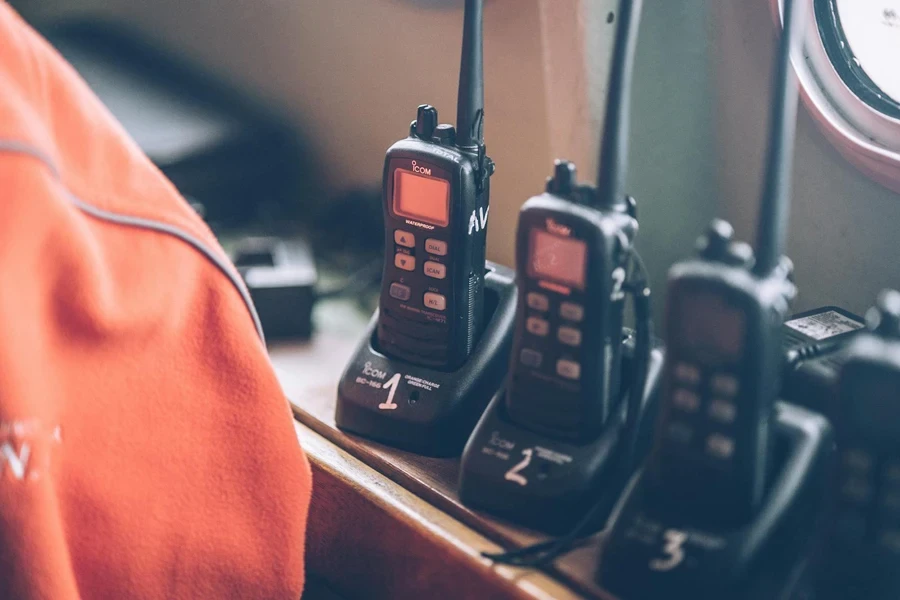Table of Contents
● Introduction
● Market overview
● Different types of walkie talkies
● Things to consider when selecting products
● Conclusion
Introduction
Walkie talkies have become indispensable communication tools across numerous industries, thanks to their reliability and ease of use. These devices are essential in environments where instant communication is crucial, such as construction sites, event management, and emergency services. The market for walkie talkies is rapidly growing, driven by advancements in technology that enhance their functionality and portability. New features like digital voice encryption, multi-band capabilities, and robust, weather-resistant designs cater to the evolving needs of professionals. As technology continues to advance, walkie talkies remain a vital component of efficient and secure communication in various sectors.
Market overview

Market scale and growth
The walkie talkie market, valued at USD 3.5 billion in 2023, is projected to reach USD 8.3 billion by 2032, growing at a compound annual growth rate (CAGR) of 9%. This growth is driven by the increasing demand for portable communication devices across various industries, technological advancements, and the need for reliable communication in industrial and commercial sectors. Additionally, innovations such as digital voice encryption and multi-band capabilities further propel the market. According to market analysis, the digital segment dominates with over 60% market share, reflecting a shift towards more efficient and secure communication solutions. The commercial and industrial segment is the fastest growing, anticipated to expand at a CAGR of over 9.5% from 2024 to 2032.
Regional insights
Regionally, the Asia Pacific holds a significant share of the walkie talkie market and is expected to maintain a robust CAGR of over 10.5% through 2032. The rapid economic growth and industrial expansion in countries like China, Japan, and India contribute to this trend. The demand for walkie talkies in sectors such as construction, manufacturing, hospitality, and security drives market growth in this region. Furthermore, the increasing use of walkie talkies for outdoor recreational activities like hiking, camping, and adventure sports adds to the market’s expansion in the Asia Pacific.
Different Types of walkie talkies

Family radio service (FRS)
Family Radio Service (FRS) radios are designed for personal, entry-level use and are widely available in retail stores. They operate on a power output of either 2W or 0.5W, providing a maximum range of up to 2 miles under ideal conditions. Despite claims of longer ranges, their effective range is often reduced by obstacles such as buildings and weather conditions. FRS radios use VHF or UHF bands, with UHF bands offering better penetration through obstacles. They are license-free, making them accessible without FCC certification, and are available exclusively as handheld units suitable for basic operations.
General mobile radio service (GMRS)
General Mobile Radio Service (GMRS) radios are designed for family and non-business use and require an FCC license for operation. These radios can output power up to 50W, significantly extending their range compared to FRS radios. GMRS units often come with mobile options that can be installed in vehicles, enhancing their utility. Recent FCC regulatory changes allow GMRS radios to transmit data such as GPS coordinates and short text messages. These radios share some frequencies with FRS but offer additional features like mobile radio capabilities and higher power outputs, making them more versatile for extended range communication.
Multi-use radio service (MURS)
Multi-Use Radio Service (MURS) radios are ideal for business and professional applications due to their programmability and secure communication capabilities. They operate at an output power of up to 2W and have a range of approximately 2 miles. MURS radios can be programmed with private channels, preventing unauthorized listening. They use five specific VHF frequencies (151.820 MHz, 151.880 MHz, 151.940 MHz, 154.570 MHz, and 154.600 MHz), ensuring secure and interference-free communication. MURS radios are robust and often built to withstand harsh environments, making them suitable for industrial use.
Things to consider when selecting products

Purpose and usage
Selecting a walkie talkie starts with identifying the intended use, as different models cater to various needs. For personal use, entry-level models operating on civil frequencies like PMR (446 MHz) or LPD (433 MHz) are sufficient. These radios typically offer features such as simple user interfaces, fixed channels, and basic encryption. For professional applications, such as construction, security, or large-scale events, more robust models are required. These devices often include advanced features like programmable channels, high power output (up to 50W), and support for both VHF (136-174 MHz) and UHF (400-470 MHz) bands, providing extended range and better penetration through obstacles.
Communication range
The effective communication range of a walkie talkie is influenced by transmitter power, antenna height, and environmental factors. A 5W transmitter can achieve a range of up to 6 kilometers in open, unobstructed environments. However, in urban areas with high building density, this range can drop significantly. Antenna height is crucial; a higher antenna can enhance signal clarity and reach. For instance, a handheld radio with a standard 10 cm antenna may have a limited range, while an upgraded 20 cm antenna can significantly improve performance. Environmental factors such as humidity, precipitation, and terrain (e.g., hilly vs. flat areas) also impact signal propagation.
Frequency range and legal requirements
Walkie talkies operate on various frequency bands, each subject to specific regulatory requirements. License-free bands like PMR (446 MHz) and LPD (433 MHz) are suitable for general use and do not require operator certification. However, professional models often use VHF (136-174 MHz) and UHF (400-470 MHz) bands, which provide better range and signal penetration but require licensing. These frequencies allow for more flexible communication setups, including the use of repeater stations to extend coverage. Ensuring that the walkie talkie’s frequency range matches existing equipment is essential to maintain compatibility and regulatory compliance.
Battery life and durability
Battery performance is a critical consideration, especially for professional use. Nickel-metal hydride (NiMH) batteries are durable and perform well in cold conditions but suffer from the memory effect and shorter lifespan. Lithium-ion (Li-ion) batteries offer higher energy density, longer cycle life, and are lighter, but they discharge quickly in extreme cold and have transportation restrictions due to safety regulations. Features like advanced power management, which includes programmable power output settings and sleep modes, can extend operational life. Durability features such as IP67 ratings for dust and water resistance, MIL-STD-810G compliance for shock and vibration, and rugged housing materials ensure the device withstands harsh environments.
Additional features
Advanced walkie talkies offer a range of features that enhance their functionality. Digital signal processing (DSP) improves voice clarity and reduces background noise, essential for noisy environments. Programmable buttons allow users to customize the radio’s functionality for specific tasks, such as activating emergency alerts or switching between channels. VOX (Voice-Activated Transmission) enables hands-free operation, which is crucial for activities requiring both hands. GPS modules integrated into some models provide real-time location tracking, which is useful for coordinating teams in large areas. Encryption standards like AES-256 ensure secure communication, protecting against eavesdropping. Additionally, modern walkie talkies often include Bluetooth connectivity for wireless accessories, making them versatile for various professional applications.
Conclusion

Choosing the right walkie talkie is crucial for ensuring effective communication tailored to specific needs and industry requirements. With ongoing technological advancements, these devices continue to offer robust, reliable solutions across various sectors. Enhanced features such as digital voice encryption, multi-band capabilities, and durable designs underscore the relevance and innovation in the walkie talkie market. Selecting a model that aligns with the operational environment and regulatory standards can significantly improve efficiency and safety in professional settings.




